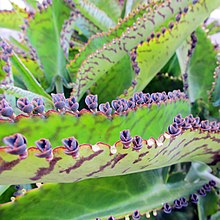| This article needs additional citations for verification. Please help improve this article by adding citations to reliable sources. Unsourced material may be challenged and removed. Find sources: "Kalanchoe daigremontiana" – news · newspapers · books · scholar · JSTOR (April 2010) (Learn how and when to remove this message) |
| Kalanchoe daigremontiana | |
|---|---|

| |
| Plantlets on leaves | |
| Conservation status | |
 Endangered (IUCN 3.1) | |
| Scientific classification | |
| Kingdom: | Plantae |
| Clade: | Tracheophytes |
| Clade: | Angiosperms |
| Clade: | Eudicots |
| Order: | Saxifragales |
| Family: | Crassulaceae |
| Genus: | Kalanchoe |
| Species: | K. daigremontiana |
| Binomial name | |
| Kalanchoe daigremontiana Raym.-Hamet & H.Perrier | |
| Synonyms | |
| |
Kalanchoe daigremontiana, formerly known as Bryophyllum daigremontianum and commonly called mother of thousands, alligator plant or Mexican hat plant, is a succulent plant native to Madagascar. Like other members of Bryophyllum (now included in the genus Kalanchoe), it can propagate vegetatively from plantlets that develop on its leaf margins, as well as through upshoots from lateral roots, and seeds. All parts of this species contain a very toxic steroid known as daigremontianin.
It is often confused with Kalanchoe laetivirens, Kalanchoe delagoensis and Kalanchoe × houghtonii. The leaves of Kalanchoe laetivirens are completely green, while Kalanchoe daigremontiana has bands or spots on the back of leaves. The leaves of Kalanchoe delagoensis are linear, while Kalanchoe daigremontiana has lanceolate, oblong, ovate or triangular leaves. Kalanchoe × houghtonii is a hybrid between Kalanchoe daigremontiana and Kalanchoe delagoensis, therefore has characteristics in between; its leaves are narrower than those of Kalanchoe daigremontiana and its leaf base is attenuate, cuneate to weakly cordate or auriculate, while Kalanchoe daigremontiana has strongly cordate to auriculate or even peltate leaves.
Morphology
Plants grow up to 1 m (3 ft 3 in) tall and have opposite and whorled, fleshy oblong-lanceolate leaves which grow up to 20 cm (8 in) long and 32 mm (1+1⁄4 in) wide. They are green above and blotched with purple underneath. Leaf margins have spoon-shaped bulbiliferous spurs which bear plantlets which may form roots while still attached to leaves.
A plant may also develop lateral roots on its main stalk, as high up as 10–15 cm (3.9–5.9 in) above the ground. A plant's upper leaves may grow large, causing its main stalk to bend downward. Then the lateral roots may enter soil and new vertical shoots may grow from the original shoot. Kalanchoe daigremontiana can spread by both seeds and by plantlets dropped from its leaves.
Kalanchoe daigremontiana has an umbrella-like terminal inflorescence (a compound cyme) of small bell-shaped, grayish pink (or sometimes orange) flowers. Flowering is, however, not an annual event and occurs sporadically if at all on some shoots. Particularly in climates with distinct seasonal temperature differences, flowering is most frequently observed at the beginning of a warm season. Indoor plants, as well as balcony plants which have been moved inside to survive the cold season, begin flowering in early winter.

As a succulent plant, Kalanchoe daigremontiana can survive prolonged periods of drought with little or no water. During growth periods with higher temperatures and increased water supply, this species requires proper nutrition, without which leaves show deficiency symptoms such as crippled growth and pustule-like lesions. The plant is not frost-hardy and typically dies in places where temperatures are below freezing.
Physiology
| This section needs expansion. You can help by adding to it. (February 2017) |
Plants of the genus Kalanchoe as well as many other plants growing in arid regions photosynthesize via Crassulacean acid metabolism.
Distribution
Kalanchoe daigremontiana is native to the Fiherenana River valley and Androhibolava mountains in southwest Madagascar. It has been introduced to numerous tropical and subtropical regions, such as Florida, Puerto Rico, Hawaii, Venezuela, Argentina, Brazil, Uruguay, and parts of southern Europe.
Habitat
Kalanchoe daigremontiana prefers to grow in rocky and dry places.
It can become an invasive plant and threaten natural ecosystems, especially in arid and semi-arid environments (South Africa and regions of South America for example), where it can inhibit native-plant recruitment.
Gallery
-
 Kalanchoe daigremontiana potted
Kalanchoe daigremontiana potted
-
 County distribution in Florida
County distribution in Florida
-
 Flowers
Flowers
-
 plantlets
plantlets
-
 plantlets
plantlets
-
 Kalanchoe daigremontiana plantlets on plantlets
Kalanchoe daigremontiana plantlets on plantlets
References
- ^ "Kalanchoe daigremontiana Raym.-Hamet & H.Perrier". Plants of the World Online. Kew Science. Retrieved 2020-10-09.
- Wagner, Hildebert; Fischer, Manfred; Lotter, Hermann (1985). "New Bufadienolides from Kalanchoe daigremontiana Hamet et Perr. (Crassulaceae)" (PDF). Zeitschrift für Naturforschung B. 40 (9): 1226–1228. doi:10.1515/znb-1985-0920. S2CID 95146056.
- McKenzie, R. A.; Armstrong, T. R. (1986). "Poisoning of cattle by Bryophyllum plants". Queensland Agricultural Journal. 112 (3): 105–108. Retrieved 27 January 2016.
- Shaw, J.M.H. (2008). "An investigation of the cultivated Kalanchoe daigremontiana group, with a checklist of Kalanchoe cultivars" (PDF). Hanburyana. 3: 17–79.
- Burnie, David (1998). The DK Nature Encyclopedia. New York: DK Publishing, Inc. pp. 29. ISBN 0-7894-3411-3.
- Batygina, T. B.; Bragina, E. A.; Titova, G. E. (1996). "Morphogenesis of propagules in viviparous species Bryophyllum daigremontianum and B. calycinum". Acta Societatis Botanicorum Poloniae. 65 (1–2): 127–133. doi:10.5586/asbp.1996.022.
- Herrera, Ileana; Ferrer-Paris, José R.; Hernández-Rosas, José I.; Nassar, Jafet M. (2016). "Impact of two invasive succulents on native-seedling recruitment in Neotropical arid environments". Journal of Arid Environments. 132: 15–25. Bibcode:2016JArEn.132...15H. doi:10.1016/j.jaridenv.2016.04.007. Retrieved 6 May 2016.
Further reading
- Everitt, J. H.; Lonard, R. L.; Little, C. R. (2007). Weeds in South Texas and Northern Mexico. Lubbock: Texas Tech University Press. ISBN 978-0-89672-614-7.
External links
- Photos of Kalanchoe daigremontiana inflorescences
- United States Department of Agriculture profile on Kalanchoe daigremontiana
- plantoftheweek.com entry on Kalanchoe daigremontiana
- Poisonous houseplants entry on Kalanchoe daigremontiana
| Taxon identifiers | |
|---|---|
| Kalanchoe daigremontiana |
|
| Bryophyllum daigremontianum |
|